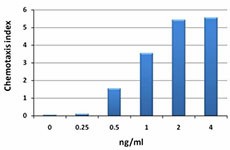- Regulatory Status
- RUO
- Other Names
- C-C motif chemokine 4, Immune activation protein 2 (ACT-2), Macrophage inflammatory protein 1-bet (MIP-1-beta), Protein H400, SIS-gamma, Small-inducible cytokine A4

-

Baf3-hCCR5 transfectants chemoattracted by mouse CCL4.
| Cat # | Size | Price | Quantity Check Availability | ||
|---|---|---|---|---|---|
| 554602 | 10 µg | $218.00 | |||
| 554604 | 25 µg | $347.00 | |||
| 554606 | 100 µg | $698.00 | |||
CCL4 is an important proinflammatory cytokine involved in acute and chronic inflammatory responses. CCL4 attracts monocytes, NK cells, dendritic cells, and lymphocytes to sites of injury and inflammation. CCL4 signals through G-protein-coupled receptor CCR5, and since CCR5 is a major co-receptor for M-tropic HIV strains, the anti-HIV effect of CCL4 has been explored. Thus, binding of CCL4 to CCR5 inhibits HIV entry and reduces the cell surface expression of CCR5. CCL4 has been identified as one of the major HIV-suppressive factors produced by CD8+ T cells. CCL4 also protects against type I diabetes by suppressing islet beta-cell inflammatory responses. In a rat model of experimental autoimmune encephalomyelitis, anti-CCL4 treatment using a neutralizing antibody significantly delayed the development, and shortened the duration, of the disease. Activated human peripheral lymphocytes secret a truncated form of CCL4 that lacks the first two amino acids. CCR5 and truncated CCL4 bind to CCR1 and CCR2. Like CCL3, CCL4 is highly acidic and can form high-molecular weight polymers. Consistent with this observation, CCL4 is secreted as high molecular weight aggregates from HIV-I specific cytotoxic T lymphocytes. The polymerization of CCL4 is reversible and is important for in vivo activity. Heterodimers of CCL3 and CCL4 have also been described.
Product Details
- Source
- Mouse CCL4, amino acids Ala24-Asn92 (Accession# NM_013652.2), was expressed in E. coli.
- Molecular Mass
- The 69 amino acid recombinant protein has a predicted molecular mass of approximately 7.8 kD. The DTT-reduced and non-reduced protein migrate at approximately 13 kD by SDS-PAGE. The predicted N-terminal amino acid is Ala.
- Purity
- >97%, as determined by Coomassie stained SDS-PAGE.
- Formulation
- 0.22 µm filtered protein solution is in 50 mM Glycine, 100 mM NaCl, pH 3.0.
- Endotoxin Level
- Less than 0.01 ng per µg cytokine as determined by the LAL method.
- Concentration
- 10 and 25 µg sizes are bottled at 200 µg/mL. 100 µg size and larger sizes are lot-specific and bottled at the concentration indicated on the vial. To obtain lot-specific concentration and expiration, please enter the lot number in our Certificate of Analysis online tool.
- Storage & Handling
- Unopened vial can be stored between 2°C and 8°C for up to 2 weeks, at -20°C for up to six months, or at -70°C or colder until the expiration date. For maximum results, quick spin vial prior to opening. The protein can be aliquoted and stored at -20°C or colder. Stock solutions can also be prepared at 50 - 100 µg/mL in appropriate sterile buffer, carrier protein such as 0.2 - 1% BSA or HSA can be added when preparing the stock solution. Aliquots can be stored between 2°C and 8°C for up to one week and stored at -20°C or colder for up to 3 months. Avoid repeated freeze/thaw cycles.
- Activity
- Bioactivity was measured by its ability to chemoattract Baf3-hCCR5 cells in a dose dependent manner.
- Application
-
Bioassay
- Application Notes
-
BioLegend carrier-free recombinant proteins provided in liquid format are shipped on blue-ice. Our comparison testing data indicates that when handled and stored as recommended, the liquid format has equal or better stability and shelf-life compared to commercially available lyophilized proteins after reconstitution. Our liquid proteins are verified in-house to maintain activity after shipping on blue ice and are backed by our 100% satisfaction guarantee. If you have any concerns, contact us at tech@biolegend.com.
Antigen Details
- Structure
- Chemokine
- Distribution
- CCL4 is secreted by many mature hematopoietic cells including macrophages, T and B lymphocytes, neutrophils, dendritic cells, mast cells and NK cells. Influenza virus-infected bronchial and nasal epithelial cells produce CCL4.
- Function
- CCL4 attracts monocytes, NK cells, dendritic cells, and T cells. CCL4 acts as HIV-suppressive factor. Activating transcription factor 3 (ATF3) limits the amount of CCL4 released by macrophages. IFN-γ and NOS2 repress CCL3 and CCL4 in mouse macrophages via ATF3.
- Interaction
- Monocytes, NK cells, dendritic cells, and lymphocytes.
- Ligand/Receptor
- CCR5
- Biology Area
- Cell Biology, Immunology, Innate Immunity, Neuroinflammation, Neuroscience
- Molecular Family
- Cytokines/Chemokines
- Antigen References
-
1. Raport CJ, et al. 1996. J. Biol. Chem. 271:17161.
2. Guan E, et al. 2001. J. Biol. Chem. 276:12404.
3. Guan E, et al. 2002. J. Biol. Chem. 277:32348.
4. Meagher C, et al. 2007. Diabetes. 56:809.
5. Maurer M and von Stebut E, 2004. Int. J. Biochem. Cell. Biol. 36:1882-6.
6. Cocchi F, et al. 1995. Science 270:1811.
7. Ren M, et al. 2010. EMBO J. 29:3952.
8. Kamin-Lewis R, et al. 2001. Proc. Natl. Acad. Sci. USA 98:9283.
9. Chandrasekar B, et al. 2013. J. Infect. Dis. 207:1556. - Gene ID
- 20303 View all products for this Gene ID
- UniProt
- View information about CCL4 on UniProt.org
